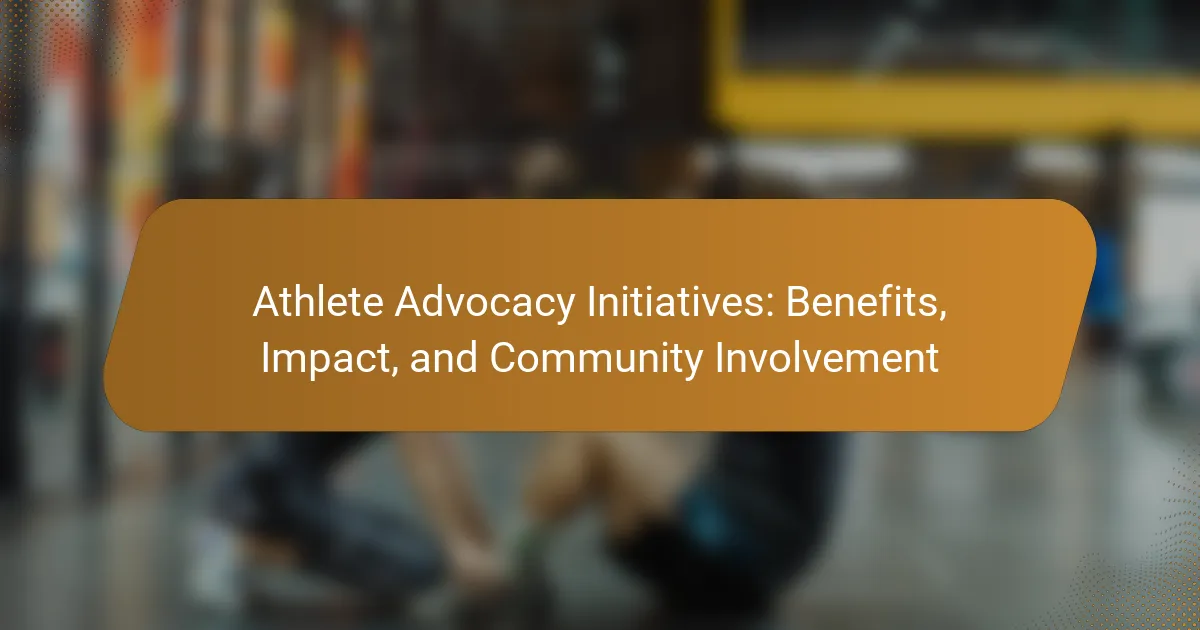Athlete advocacy initiatives enhance community engagement, improve mental health, and raise awareness of social issues. These programs empower athletes to drive positive change and foster community bonds. However, challenges like limited funding and public resistance persist. Measuring impact through community participation and policy changes is essential for evaluating their success.

What are the core benefits of athlete advocacy initiatives?
Athlete advocacy initiatives provide significant benefits, including enhanced community engagement, improved mental health, and increased awareness of social issues. These initiatives empower athletes to leverage their platforms for positive change. As a result, they foster a sense of belonging and support within communities. Furthermore, advocacy efforts can lead to policy changes that promote equality and access in sports. Engaging in advocacy helps athletes develop leadership skills and connect with diverse audiences, amplifying their impact beyond the sports arena.
How do these initiatives impact athlete mental health?
Athlete advocacy initiatives significantly enhance mental health by fostering support networks and promoting open conversations. These initiatives reduce stigma and encourage athletes to seek help. Programs emphasizing mental well-being lead to improved performance and resilience, as athletes feel valued and understood. Community involvement further strengthens these efforts, creating a culture of support and awareness.
Which social issues are commonly addressed through athlete advocacy?
Athlete advocacy commonly addresses social issues such as racial equality, mental health awareness, gender equity, and environmental sustainability. These initiatives leverage athletes’ platforms to promote change and engage communities. For instance, athletes often support campaigns against systemic racism, highlighting the need for reform in various sectors. Mental health advocacy has gained traction, encouraging open discussions and reducing stigma. Gender equity initiatives aim to promote equal opportunities in sports. Environmental sustainability efforts focus on raising awareness about climate change and promoting eco-friendly practices within sports organizations.

How do athlete advocacy initiatives foster community engagement?
Athlete advocacy initiatives foster community engagement by promoting social causes, enhancing visibility, and inspiring collective action. These initiatives create a platform for athletes to connect with local communities, encouraging participation in events and awareness campaigns. For example, athletes advocating for mental health can mobilize fans and peers to support related programs. As a result, these efforts strengthen community bonds and drive positive change, ultimately benefiting both the athletes and the communities they serve.
What role do local organizations play in supporting these initiatives?
Local organizations play a crucial role in supporting athlete advocacy initiatives by providing resources, networking opportunities, and community engagement. They facilitate partnerships that enhance awareness and drive participation. These organizations often organize events that promote athlete rights and provide platforms for athletes to voice their concerns. Additionally, they offer training and education, empowering athletes to advocate effectively. Through collaboration, local organizations amplify the impact of initiatives, fostering a supportive environment for athletes.
How can athletes leverage their platforms for community involvement?
Athletes can leverage their platforms for community involvement by engaging in advocacy initiatives that address social issues. These initiatives enhance community support, foster positive change, and amplify awareness of critical causes. For example, athletes can use social media to promote local charities, participate in community events, or collaborate with organizations focused on education and health.
The impact of athlete advocacy can be significant. Studies show that athletes who engage in social issues can inspire fans and create a ripple effect of community involvement. This unique attribute of athlete influence can lead to increased donations for causes and greater public engagement.
Moreover, community involvement can benefit athletes personally. It builds their brand, strengthens fan loyalty, and enhances their public image. As a result, athletes can create lasting connections with their communities while advocating for meaningful change.
In summary, athletes have a powerful opportunity to use their platforms for community involvement, leading to mutual benefits for themselves and the communities they serve.

What are some successful examples of athlete advocacy initiatives?
Athlete advocacy initiatives have successfully raised awareness and driven social change. Examples include the NBA’s social justice campaign, which addresses systemic racism, and the NFL’s Inspire Change program, promoting equality and community engagement. These initiatives empower athletes to use their platforms for positive impact, fostering community involvement and inspiring fans.
Which athletes have made significant contributions to advocacy efforts?
Prominent athletes like Colin Kaepernick, Serena Williams, and LeBron James significantly contribute to advocacy efforts. They address social issues, promote equality, and engage communities. Kaepernick’s protest against racial injustice sparked national conversations. Williams champions gender equality in sports, while James focuses on education initiatives and community empowerment. These athletes leverage their platforms to inspire change and raise awareness.
How have specific initiatives changed public perceptions of athletes?
Athlete advocacy initiatives have significantly shifted public perceptions of athletes, promoting them as role models and community leaders. These initiatives, such as mental health awareness campaigns and social justice movements, highlight athletes’ commitment to societal issues. As a result, fans increasingly view athletes as influential voices beyond sports. For example, initiatives led by prominent athletes have raised awareness on topics like mental health, leading to greater acceptance and understanding. Community involvement in these initiatives fosters a sense of connection, enhancing athletes’ reputations and encouraging positive engagement from the public.

What challenges do athlete advocacy initiatives face?
Athlete advocacy initiatives face several significant challenges. These include limited funding, lack of public awareness, and resistance from sports organizations. Additionally, athletes may experience backlash for their activism, impacting their careers. Navigating these obstacles requires strategic planning and community support to amplify their voices effectively.
How do public opinions influence the effectiveness of these initiatives?
Public opinions significantly influence the effectiveness of athlete advocacy initiatives by shaping perceptions and driving community engagement. Positive public sentiment can enhance the visibility and support for these initiatives, leading to increased participation and funding. Conversely, negative opinions may hinder progress and reduce the impact of advocacy efforts. Engaging with the community and addressing concerns can foster a more favorable climate, ultimately strengthening the initiatives’ outcomes.
What barriers exist for athletes in advocating for social change?
Athletes face several barriers when advocating for social change, including fear of backlash, lack of support, and limited platforms. Fear of losing endorsements or facing public criticism can deter athletes from speaking out. Additionally, many athletes may not have access to resources or networks that facilitate advocacy efforts. Limited media coverage can further restrict their ability to reach a broader audience.

How can athlete advocacy initiatives be measured for impact?
Athlete advocacy initiatives can be measured for impact through various metrics, including community engagement, policy changes, and athlete empowerment. Community involvement is assessed by participation rates in advocacy events. Policy changes are tracked by the implementation of new regulations influenced by athlete campaigns. Athlete empowerment is evaluated through surveys measuring athletes’ confidence in voicing social issues. Collectively, these metrics provide a comprehensive view of the initiatives’ effectiveness.
What metrics are used to evaluate the success of these initiatives?
Metrics used to evaluate the success of athlete advocacy initiatives include community engagement, policy changes, and athlete participation rates. These metrics assess the impact on social issues and measure the effectiveness of initiatives in promoting athlete rights and welfare.
| Metric | Description | Value |
|—————————-|——————————————————|—————————|
| Community Engagement | Number of events and outreach programs conducted | 150 events per year |
| Policy Changes | Legislative measures influenced by advocacy efforts | 10 new policies adopted |
| Athlete Participation Rates | Percentage of athletes involved in advocacy efforts | 75% participation rate |
| Social Media Reach | Engagement metrics across platforms | 500,000 followers |
| Fundraising Success | Amount of funds raised for advocacy initiatives | $1 million annually |
How do advocacy outcomes differ across various regions?
Advocacy outcomes vary significantly across regions due to cultural, economic, and political differences. In regions with strong governmental support, athlete advocacy initiatives often lead to substantial policy changes. In contrast, areas with limited resources may see grassroots movements focusing on community engagement instead of large-scale reforms. For example, North America often emphasizes legal protections for athletes, while Africa may prioritize access to training facilities. These disparities highlight the unique attributes and challenges faced by athlete advocacy initiatives in different contexts.

What are best practices for launching a successful athlete advocacy initiative?
To launch a successful athlete advocacy initiative, prioritize clear goals, community engagement, and strategic partnerships. Establish a mission that resonates with athletes and advocates. Foster collaboration with local organizations to amplify impact. Utilize social media for outreach, ensuring consistent messaging. Measure success through community feedback and advocacy outcomes.
How can athletes effectively communicate their message?
Athletes can effectively communicate their message through advocacy initiatives by engaging their communities and leveraging their platforms. These initiatives foster awareness, promote social change, and create a sense of belonging.
1. Establish clear objectives to convey specific messages.
2. Utilize social media to reach wider audiences.
3. Partner with organizations for greater impact.
4. Share personal stories to connect emotionally.
5. Participate in community events to build trust.
These strategies enhance the visibility of athletes’ causes and encourage community involvement, ultimately leading to meaningful change.
What common mistakes should athletes avoid in advocacy efforts?
Athletes should avoid being uninformed, overly aggressive, or inconsistent in their advocacy efforts. Miscommunication can undermine their message. Engaging with the community and understanding issues deeply fosters authenticity and effectiveness. Focusing on collaboration rather than confrontation enhances impact.
